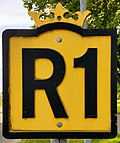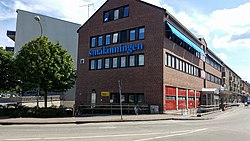Ljungby
Ljungby is an urban area in the county of Kronoberg in Sweden. It is the seat of Ljungby Municipality. In 2015 there lived 15,785 people in Ljungby.
 | |
| Coordinates: 56°50′N 13°56′E / 56.833°N 13.933°ECoordinates: 56°50′N 13°56′E / 56.833°N 13.933°E | |
| Country | Sweden |
| Province | Småland |
| County | Kronoberg County |
| Municipality | Ljungby Municipality |
| Area | |
| • Total | 11.93 km2 (4.61 sq mi) |
| Population (31 December 2010)[1] | |
| • Total | 15,205 |
| • Density | 1,274/km2 (3,300/sq mi) |
| Time zone | UTC+1 (CET) |
| • Summer (DST) | UTC+2 (CEST) |
History
11th century to 1828, before Ljugby became a town
The first know persons to live in the area around Ljungby was Astrad and Götrad. Astrad and Götrad lived during the Viking Age in the 11th century. We know about them because Götrad made a runestone, The Replösa Stone, for his dead father Astrad.
The first stone church was built in during the 12th century. It was built with the creation of Ljungby parish.
In the 14th century an inn was built in Ljungby by order of the king. They built it because Ljungby lies were two big trade routes cross.
During the 17th and 18th century the inn was owned by a woman named Märta Ljungberg. Märta Ljungberg earned a lot of money from the inn. She used some of the money to buy twelve other farms. The town of Ljungby would later be built on these twelve farms.
In the beginning of the 19th century there was a need of a town in Sunnerbo hundred. There were two places that would fit a town. One was Berga and the other was Ljungby. Berga had got permission to form a town during the 13th century, but the town had never been formed. Ljungby was located more central in Sunnerbo hundred and had better road connections. In the end it was decided that the town should be built in Ljungby.
1828 to today, the town Ljungby
Sometime between 1828 and 1830 the area known as Ljungby was made into a friköping. A friköping is a type of smaller town, but it does not have the same town privileges as a formal town. The new town Ljungby was founded on the ground donated by Märta Ljungberg.
In 1878 the first railroad was built in Ljungby. The railroad went from Vislanda, via Ljungby, to Bolmen. After some years it had been connected with other railroads and went to Karlshamn in east and to Halmstad in west. In 1899 the north-south railroad Skåne–Smålands Railroad opened.
During the 20th century Ljungby expanded with the help of workshops and wood industry. The biggest expansion was between 1940 and 1960.
In 1953, during the night between 4 July and 5 July, there was a big town fire in Ljungby. The fire had damaged twenty buildings. Thirty families became homeless and 96 persons lost their job.
In 1970 the Karlshamn–Vislanda–Bolmens Railroad was closed down. Less and less cargo was being transported by train and was instead replaced by lorries.
The last train in Ljungby passed in 1997 when the cargo route Helmershus-Ljungby ended. After the railroad was removed, much of the former tracks have been converted into bicycle paths.
The first college in Ljungby opened in 2002, Högskolecentrum Ljungby. It cooperates with the three nearby universities Linnaeus University, Jönköping University, and Halmstad University.
Culture
Ljungby have been the home of several cultural persons. Among others, the cinematographer Gunnar Fischer and the writers Folke Fridell, Lennart Williams, and Sölve Rydell. Ljungby does also have two museums, a library, a theater, and a cinema.
The Ljungberg Museum
Ljungbergmuseet, or The Ljungberg Museum in English, is a museum with paintings in Ljungby. The museum do always show paintings and other art pieces by Sven Ljungberg and his wife Ann Margret Dahlquist-Ljungberg. They do also show other temporary exhibitions by other artists.
The museum was built in 1990 and was made bigger in 2002. The museum was designed by the architect Pontus Ljungberg. Pontus Ljungberg is the son of Sven Ljungberg and Ann Margret Dahlquist-Ljungberg.
In 2012 it was decided that the museum should become Kronoberg's official museum of visual art.
The Museum of Legends
Sagomuseet , or The Museum of Legends in English, is a museum about folklore in Ljungby. The museum show old legends and fairytales that have been told around Ljungby and Kronoberg. The museum have also put up signs around Kronoberg that tell stories about the location.
Every year the museum have a storytelling festival, Berättarfestivalen. During Berättarfestivalen people gather to listen to storytellers from around the world.
In 2013 the owners of The Museum of Legends, the Storytelling Network Kronoberg, became an advisor to Swedish UNESCO about the intangible cultural heritage.
Ljungby library
Ljungby kommunbibliotek , or Ljungby library in English, is visited by 500 to 800 people per day. The library also haves a café and a small art gallery. The library was built in 1982, but there have been other libraries in Ljungby since 1920.
Ljungby library is responsible for smaller libraries in Lagan, Ryssby, and Lidhult. Ljungby library do also have a mobile library, a bus filled with bookshelves. They use this bus to reach people who live in small places around Ljungby Municipality.
Ljungby Media
Tellushuset is one of the few historical buildings that wasn't destroyed in the 1953 fire. The former city center, that existed before the fire, was built in a similar style.
After the fire of 1953 many of the buildings was rebuilt in a then modern style, which today is still considered controversial. The picture shows Hotell Terraza with its international style.
The scenic route Riksettan goes through Ljungby city center.
The regional paper Smålänningen's head office in central Ljungby.
Högskolecentrum Ljungby has its premises on the second floor of the building "Garvaren".
The exterior of Ljungby Church.
Annelundkyrkan located at Skogskyrkogården cemetery.
References
- ↑ 1.0 1.1 "Tätorternas landareal, folkmängd och invånare per km2 2005 och 2010" (in Swedish). Statistics Sweden. 14 December 2011. Archived from the original on 10 January 2012. Retrieved 10 January 2012.
{{cite web}}: CS1 maint: unrecognized language (link)
Other websites
![]() Media related to Ljungby at Wikimedia Commons
Media related to Ljungby at Wikimedia Commons










